Usually I first pick a dish and then the wine, but for the antipasto for this year’s Christmas dinner I did it the other way around. A friend of ours had brought a sparkling red from the Loire region, made from cabernet franc. I thought it would be great with the ham of lamb that I made last year, when paired with some salt-roasted beetroot. This way of preparing beetroot concentrates the flavor without making the beets too salty.

I prepared the ham of lamb slightly differently, as I brined it rather than cured it and cooked it bone-in. Although I haven’t tasted them side by side, I don’t think I could detect much difference with last year’s version. The salt-roasted beetroot was great, and it all worked out as planned: the combination of the beetroot, ham of lamb, and the sparkling red wine was wonderful. Here’s what I did.
Ingredients
one leg of lamb or part thereof, bone-in (I used the lower part of the leg of about 900 grams, 2 lbs)
salt and sugar for the brine
fresh rosemary
black peppercorns
juniper berries
olive oil
2 Tbsp sawdust for smoking
mini beetroots
as much coarse sea salt as needed to cover them
freshly grated horseradish for garnish
extra virgin olive oil
balsamic vinegar ‘tradizionale’ (the expensive stuff)
Preparation

Put the leg of lamb in a container into which it snugly fits and cover with cold water.

Measure the amount of water needed to cover the leg of lamb, in my cases 2060 grams of water.

I like using an equilibrium brine. This means that the amount of salt is calculated such that you will end up with the desired level of saltiness. When using a very salty brine, the brining time will determine how salty it will become. With an equilibrium brine, if you wait long enough, the equilibrium will be reached and the amount of salt will be the calculated amount.
I wanted to have a saltiness of 1% by weight. With about 800 grams of lamb (estimated weight without the bone) and 2060 grams of water, 1% of that is 28 grams of salt.

I also added sugar for the amount of 40% of the weight of the salt.
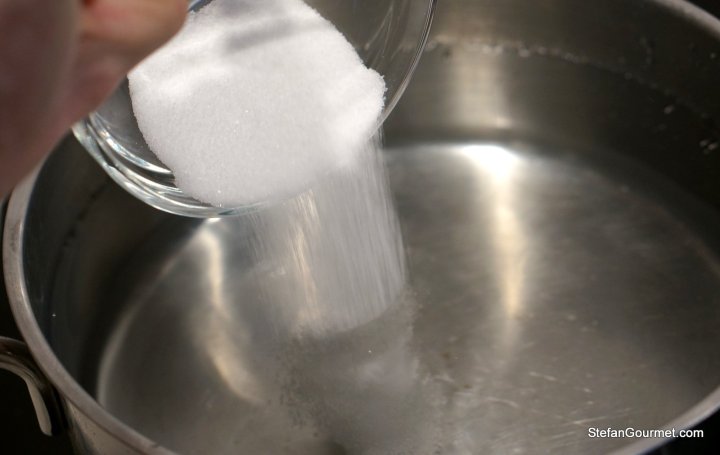
I put the 2060 grams of water in a saucepan and add the salt…

…and rosemary, peppercorns, and juniper berries.

I brought this to a boil and then turned off the heat. Boiling the brine like this will sterilize it, and makes it easier for the salt and sugar to dissolve.
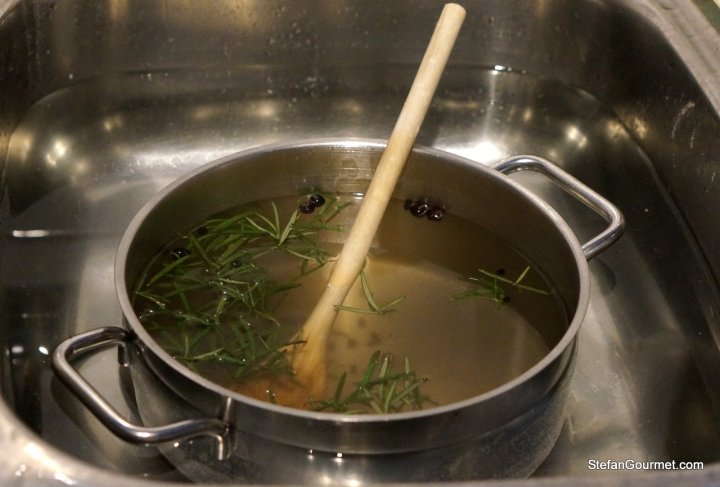
I allowed the brine to cool in an ice bath.

Then I transferred the brine to the container…
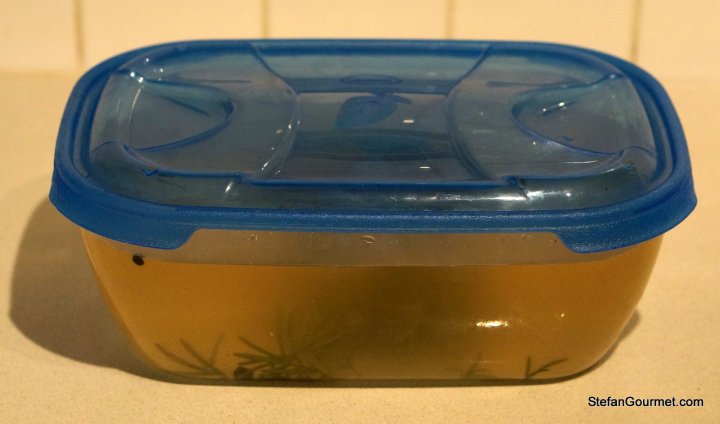
…covered it, and refrigerated it.

Once the brine had reached refrigerator temperature, I added the lamb and brined the lamb in the refrigerator for 48 hours.

After that I discarded the brine and patted the lamb dry with paper towels.

…and rubbed the lamb with olive oil.

I closed the smoker and lit the burners underneath.

I allowed the lamb to smoke for 15 minutes. You could now finish the lamb in an oven at 160ºC/325ºF until the core temperature reaches 55ºC/131ºF. Instead I wanted to finish the lamb sous-vide, so I let it cool off to room temperature.

I then vacuum sealed the lamb…

…and I cooked it sous-vide for 12 hours at 57ºC/135ºF.

I chilled the lamb quickly in ice water (i.e. tap water, this time of year).

A gratuitous ham of lamb shot if ever there was one.

Since I wanted to slice the hamb on the machine, I had to remove the bone.

With the bone removed, the ham had a big hole. I decided to use transglutaminase to glue it back together.

I combined 10 grams of transglutaminase with cold water to make a slurry, and I brushed the cut part with this mixture.

Then I closed the ham as best as I could and vacuum sealed it. I refrigerated the ham like this for 4 hours to allow the transglutaminase to do its job.
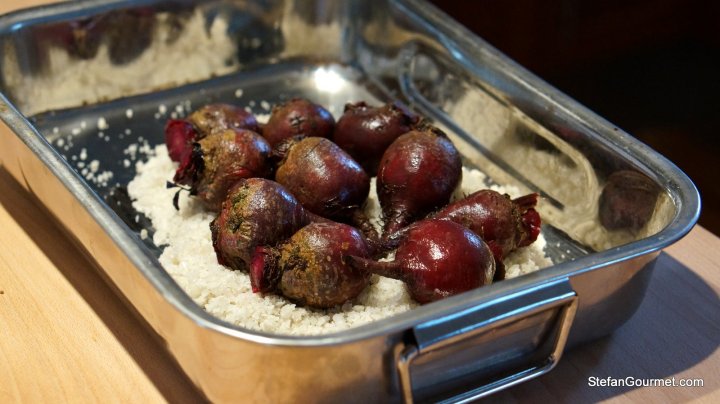
Meanwhile, it was time to start thinking about the beets. I preheated the oven to 190ºC/375ºF (with fan). I trimmed the beets, but didn’t peel them, and arranged them in an oven dish on top of a layer of coarse sea salt.

I then covered them with sea salt. They should actually be covered completely, but I ran out of coarse salt and on Christmas day I couldn’t buy any more.
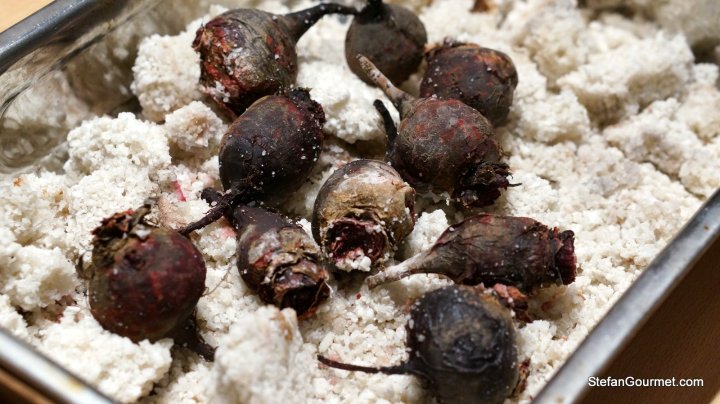
I roasted the beets in the oven at 190ºC/375ºF (with fan) for 75 minutes or until they were tender (when pierced with a fork). I allowed them to cool before breaking open the salt crust that had formed.

The peel could now be rubbed off easily.
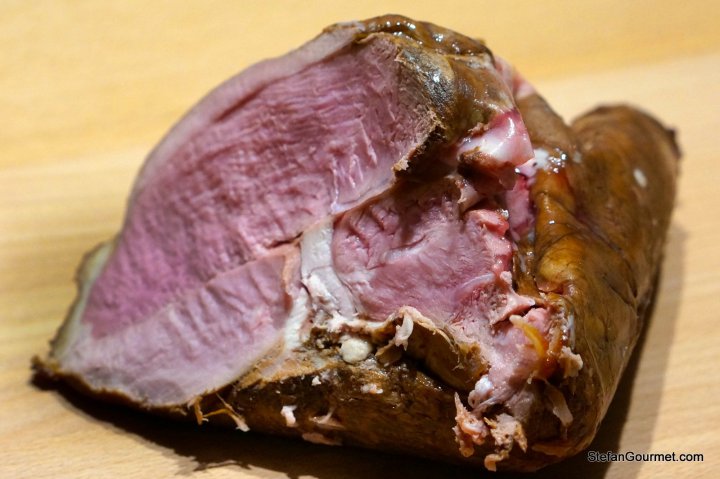
The transglutaminase had done its job, what a fine looking ham.

Kees sliced the ham on the machine.

I served the sliced ham of lamb with the salt-roasted mini beetroot. I drizzled everything with good extra virgin olive oil and the beetroot also with good balsamic. I garnished the beetroot with freshly grated horseradish.
Wine pairing
 The wine that was the inspiration for this dish was this sparkling red from Loire made from cabernet franc. If you can’t find something similar, a rosé champagne or ligth red would also be an excellent combination.
The wine that was the inspiration for this dish was this sparkling red from Loire made from cabernet franc. If you can’t find something similar, a rosé champagne or ligth red would also be an excellent combination.
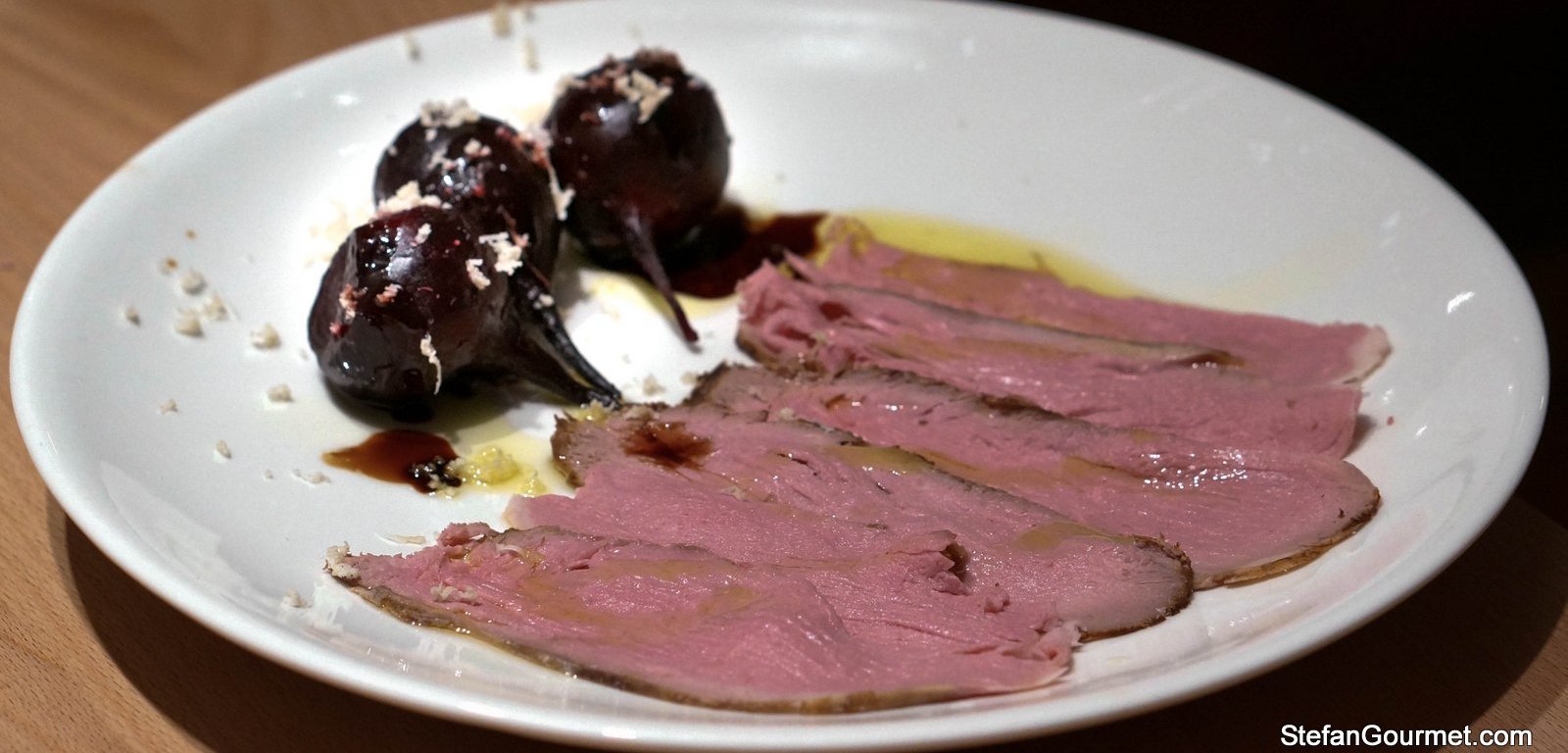

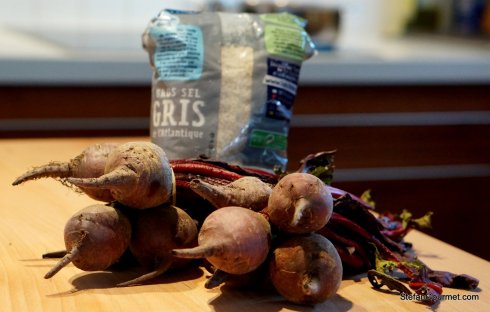




Stefan – Well, you certainly went through great lengths with the delicious, tender lamb. I have never seen a lamb brined, smoked and vacuumed sealed – or beets roasted on sea salt! Lamb and beets are two of my all time favorite foods – and one can’t argue with a lovely cabernet franc. I am, as always impressed (and hungry now). Happy New Year! – Shanna
LikeLike
Wow!!! Cooking this lamb was a life commitment! 😉 I’m not going to deny it: it looks gorgeous! Tender and moist and the color is just perfect! Still I don’t see myself committing for 12 hours! 😉 I raise my glass to you … green with envy! 😉
LikeLike
Thanks Francesca. The great thing about cooking sous-vide is that I can completely forget about the lamb for those 12 hours. It is not necessary at all to check it. I just put it in the sous-vide cooker and then 12 hours later I take it out again. That’s all. In this case it was still quite a bit of work with the brining and smoking as well.
LikeLike
OK. I’m duly impressed. Great post! The technique is impeccable and I love that Kees is using a kitchen tool with a cord. 😉 I love it. I never would have considered brining/wet curing a leg of lamb. I have brined/wet cured pork and chicken because they are so lean but never a red meat. Now I’m very curious. Also, why did you decide on a 1% brine as opposed to 2% or 5%?
LikeLike
LOL. Kees thought I was going to cut off my fingers and took over 😉 I basically treated the ham of lamb as if it were a ham of pork. It was my butcher actually who suggested the wet cure, but I think next time I’ll do a dry cure again as it saves the trouble of boiling and then cooling the brine.
I decided on a 1% brine because I wanted to do an equilibrium brine (the brine actually starts out as a 1.4% brine with 0% salt in the lamb; at the end of the cure an equilibrium is reached where the salt has gone down in the brine from 1.4% to 1% and has gone up in the lamb from 0% to 1%; both at 1% is the equilibrium). With a 5% brine, the amount of time the lamb spends in the brine will determine the saltiness and there will also be more of a salt gradient in the lamb. I’m not sure that 48 hours was actually enough, 72 hours would have been better to avoid having any salt gradient at all. Hope this makes sense.
LikeLike
Super technical walkthrough and great technique. I approve of the gratuitous shot too.
LikeLike
Thanks, Conor, that means a lot 🙂
LikeLike
another post on amazing technical cooking! I really enjoy reading about how you get in there, and spend the time and effort into elevating your ingredients through through great cooking technique. Curing lamb…, smoking and equilibrium brining, this is wonderful! thank you Stefan! I surely want to try this as soon as I find some free time after the move!
LikeLike
Thanks, Paul. Good luck with the move!
LikeLike
When did you say you were going to open your own restaurant?
LikeLike
I’m actually trying to figure out when I’ll be able to do so on my terms — which will probably take at least another decade of keeping my ‘day job’ to save up.
LikeLike
Another find dish, Stefan. These lamb slices could not look more appetizing, at least to my eyes. This post was a well-written how-to for preparing the lamb and the dish itself was such a delicious way to start a holiday meal.
LikeLike
Thanks, John. I still have some leftovers of the ham, so I’m having really nice sandwiches for lunch 🙂
LikeLike
Ooh yum!
My other half loves lamb, and I love smoking stuff – so this is another must do!
What size is your hot smoker?
I’ve done hot smoking with lumps of wood in the barbecue, but that’s more of a summer job – and the only place I can think of to cold smoke is either the barbecue or the wood fired oven – both of which are a pain in the winter! I didn’t fancy paying £25 or so for a cardboard box for the cold smoker 🙂
http://www.souschef.co.uk/proq-eco-smoker.html?origin=product-search&kwd=&source=pla&gclid=CNrulauC3bwCFUtV4godYnoA5Q
but since I have the sawdust maybe I should investigate a hot smoker?
thanks lots for the idea
Sali
LikeLike
My hot smoker is about 40x25x10 cm (16x10x4 inches) and cost about the same as the ‘cardboard box’.
The hot smoker is also great for fish (trout, salmon, mackerel), duck breast, etc.
LikeLike
Thanks Stefan! I’ll investigate…
LikeLike